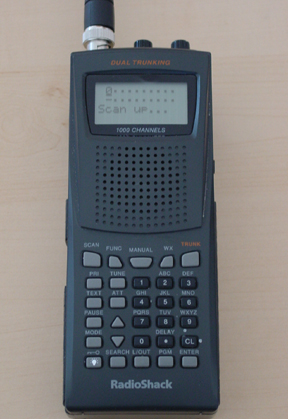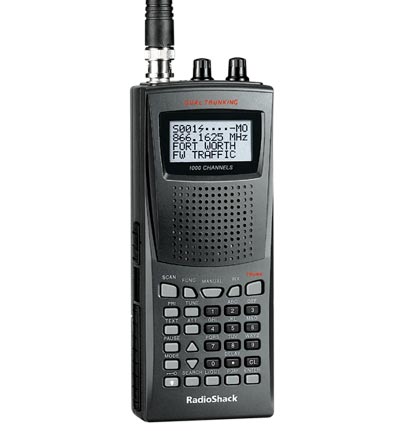RADIO MONITORING
SCANNING... An extension of my radio hobby
While scanning is usually thought of in terms of a 'police scanner', such radios can be used to listen to a LOT more than police - like firefighters, commercial and military aircraft, railroad, federal and local governments, weather, newspapers, TV crews, marine, satellites, power/water/cable/TV/telephone workers, sports teams, race cars and so much more! There are also many radios available which can be used to listen to signals from around the globe on the shortwave bands.
What Is A Scanner?
-
- A scanner/receiver is much like the radio in your car. It is able to tune to a selected frequency and then extracts the audio portion of the signal which gets fed to an amplifier and then sent to a speaker for you to hear.
- If you have a modern radio in your car, it probably has a number of station presets. And you've probably programmed each preset with a favorite radio station. Then when you press a particular preset button, the radio tunes to the appropriate frequency.
- Many radios have more than one set of presets too. Something like FM1 and FM2 etc. Pressing FM1 enables the presets that were programmed for it and FM2 contains a whole other set. So if you have 6 presets for both FM1 and FM2, you have twelve frequencies you can program.
- Let's say, instead of calling them presets, we call them "channels". And let's refer to FM1 and FM2 as "banks". Your car radio then has two banks with six channels each, right? You can now think of your car radio in terms of a scanner! Most scanners come with anywhere from 5 to 20 banks with anywhere from 10 to 50 channels per bank. Since each channel can be programmed to hold a discrete frequency, an average scanner can be programmed with 50 to 1000 frequencies! That may seem like a lot, but remember, the range of radio frequencies that are out there is HUGE!
A Scanner Therefore Scans
-
- Unlike broadcast radio and TV which transmit pretty much 24 hours a day, services such as police and fire only transmit when a person presses the transmit key on the microphone. If there is no transmission, there is only static on that frequency. This is where scanning comes in.
- When you tell the scanner to start scanning, it examines each of the frequencies you have programmed it. It looks at the first frequency and checks to see if someone is transmitting on it. If there is no transmission detected, it simply moves on to the next channel to check it.
- If there is a transmission, it pauses the scan operation, extracts the audio, amplifies it and sends it to the speaker for you to hear.
- When the transmissions stops, the receiver continues on to the next channel. When it reaches the last channel, it starts over at the first channel and repeats the process.
A Scanner Can Search To?
-
- Have you ever been in a strange area and used the "tune" function of your radio to search for a station? This is called searching and most good scanners can do this.
- If your scanner has a limit search, you can tell it to search for active frequencies between two specified frequencies. You usually specify a start frequency and an end frequency and tell the scanner to search between these two frequencies.
- The scanner starts at the first frequency and checks for a transmission. If there is none, it goes to the next frequency and repeats the process. Just like scanning, if a transmission is found, you get to hear what is being broadcast on it.
- If your scanner has band search, you select the band (consisting of a pre-programmed start and end frequency) you want to search and off it goes. While not as flexible as a limit search, it still gives you the ability to search for new frequencies.
- If your scanner has service search, this is really just a scan operation which searches for activity among a set of pre-programmed frequencies. They are usually kept in a separate memory and can not be altered.
So Now You Know
-
- There you have it. A scanner is a radio receiver that has the ability to scan pre-programmed channels that you know of, as well as the ability to search for new ones. Just like your car radio! Just think of it as a specialized scanner that can receive a small portion of the radio spectrum.
So What's A Communications Receiver
-
- This is really nothing more than a fancy name for a scanner.
- However, a communications receivers usually has at least one VFO linked to a rotary control and allows the frequency step size and receive mode to be altered .
- Communications receivers usually scan and search a lot slower than a "pure-bred" scanner.
- To make a broad generalization, Alinco, AOR, Icom, WiNRADiO, Yaesu and Yupiteru make models that would be termed communications receivers while Radio Shack and Uniden make scanners.
- There are even some radios that call themselves multi-band receivers. Same difference.
Trunked Radio Systems
With more and more agencies going to trunked radio systems (multi-channel, computer-controlled) for more efficient use of their bandwidth, it's worth the effort to see if you would benefit from buying a scanner which can track transmissions on one of these "high tech" systems.
Trunked radio systems are usually used by public safety and businesses in and around urban areas where the number of users is large and the cost can be paid by local government taxes or expensive leasing fees. Therefor, if you live in or near a large urban area, check into whether or not there are trunked systems you wish to monitor. If you live in the "sticks", this type of radio PROBABLY won't be a consideration.
If you do find there are one or more trunked radio systems you wish to scan, then you'll have to determine if these systems can be tracked by the current set of scanners. Not all trunked systems are the same!
The two predominant trunked types are Motorola and GE/Ericsson with Motorola being the more popular. You must also consider whether the signals they carry are analog or digital. There are now scanners that can handle digital trunked systems. These scanners have been on the market over the past two years and this segment of the industry is experiencing rapid development and growth.
While most trunked systems are on 800 MHz, they can also be found in the 100, 400, 500, and 900 MHz ranges! Be sure to investigate what your needs are, then make sure you pick the radio which can handle trunked systems in these frequency ranges. Not all scanners are created equal!
RADIO SHACK PRO-2066
This was my first Trunk-Tracking capable scanner. Manufactured by GRE for Radio Shack, this radio has 150 memory channels organized in 5 banks of 30 channels. This radio is still operational in my shack today.
PRO-95 SPECIFICATIONS
| Type: | HF/VHF/UHF receiver/scanner |
| Frequency range: | 25-54 / 108-174 / 216-225 / 406-512 / 806-824 / 851-869 896-960 /1240-1300 MHz |
| Mode: | AM/FM |
| Sensitivity: | N/A |
| Selectivity: | N/A |
| Image rejection: | N/A |
| Voltage: | 4.8-6 VDC (4*R6) |
| Current drain: | ? mA |
| Impedance: | 50 ohms, BNC |
| Dimensions (W*H*D): | ? mm |
| Weight: | ? gr |
| Manufactured: | 200x-200x |
| Other: | 1000 memories. Weather alert. Dual trunking New price 2002 in the US: .95 |
| Related documents: |
Mini-Review of the PRO-95 Dual Trunking Scanner
In late 2002, Radio Shack released the PRO-95, custom made in China for GRE. Prior to this, some of Radio Shacks hottest models were the PRO-92 and PRO-2067. However, the PRO-92 had several flaws, especially in early models. One big issue was with the scanner having trouble tracking trunked radio systems. Furthermore, several hobbyists plainly described their PRO-92 as being "deaf". Radio Shack soon released several other hand held scanners: the PRO-93 and PRO-94. As of this writing, Radio Shack currently offers just the PRO-94, along with the newer PRO-95.
While priced a tad higher than its competitor, the Uniden BC 245XLT, it offers one really nice feature we think is an absolute must in scanners: alphanumeric tags. Tracking of two systems at once is flawless. We have used the PRO-95 to monitor two Motorola Type II systems with no problem at all. Try that with your PRO-92 or PRO-2067 and you will see what we are talking about. Talkgroups are caught instantly with no delay, something nice to have when you monitor large systems.
The PRO-95 covers the following bands:
- 25 - 54 MHz
- 108 - 136.9875 MHz
- 137- 174 MHz
- 216.0025 - 225 MHz
- 406 - 512 MHz
- 806 - 823.9875 MHz
- 894 - 960 MHz
- 1240 - 1300 MHz

As you can see, there is no coverage of the MilAir bands, a very popular monitoring targets of scanner hobbyists. While we are not exactly sure behind Radio Shack's reasoning, a safe bet would be costs. However, the popular public safety bands are covered and for the majority of scanner hobbyists that monitor police and fire communications, this should fit their bill.
While the PRO-95 is a nice scanner, it should not be considered a top of the line scanner. For starters, there is no CTCSS or DCS decoding available on the PRO-95, a feature found on the PRO-92 and available on Uniden's newer BC-250D scanner. Furthermore, if you have any LTR systems in your area, don't count on using the PRO-95. Thankfully, though, there are not many LTR systems in use for public safety.
Overall, the PRO-95 though is a good scanner that most scanner hobbyists will a useful addition to their radio monitoring arsenal. Here are some unique features to this radio:
- The ability to mix and match two types of trunked radio systems, (such as one Motorola and EDACS system) and also monitor conventional systems at the same time.
- 1,000 channels- 10 banks of 100 channels each , 10 X 100 = 1,000 channels.
- 12 character, 4 line display alphanumeric display.
- Triple Conversion.
- Scan speed- 60 channels per second. Search speed- 75 frequencies per second.
- Attenuate Feature- this feature helps eliminate or cut down on strong interference or noise signals.
- Multiple Power Options- Unlike Uniden models, where you have to use the battery pack or the supplied "wall wart", the PRO-95 allows you to use rechargeable batteries, non-rechargeable batteries, or a "wall wart".
- Good Overall Volume- Compared with the Uniden BC 245 XLT, we found the volume to be much more superior. Even traveling down the road with windows open did not prevent us from hearing the radio traffic.


PRO-2066 SPECIFICATIONS
| Type: | VHF/UHF receiver/scanner |
| Frequency range: | VHF/UHF |
| Mode: | AM/FM |
| Sensitivity: | N/A |
| Selectivity: | N/A |
| Image rejection: | N/A |
| Voltage: | 13.8 VDC |
| Current drain: | Max ? mA |
| Impedance: | 50 ohms |
| Dimensions (W*H*D): | ? mm |
| Weight: | ? Kg |
| Manufactured: | 19xx-19xx |
| Other: | Trunking. 150 memories |
| Related documents: |
